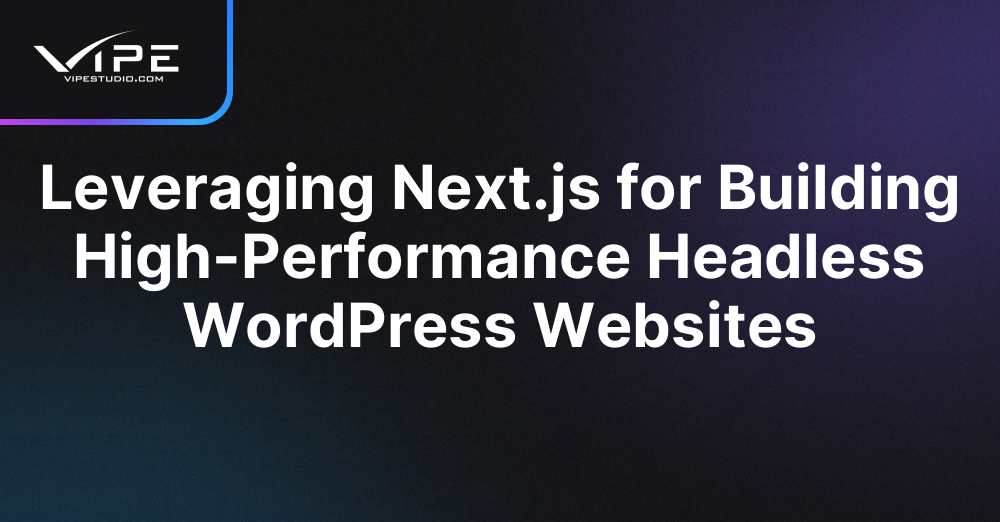11.06.2025
WordPress Development
Leveraging Next.js for Building High-Performance Headless WordPress Websites
READING TIME: MIN
Table of Content
As businesses demand faster, more interactive, and highly scalable web experiences, the combination of WordPress and Next.js has become one of the most powerful solutions available. By decoupling the backend from the frontend, enterprises can build robust headless websites that deliver exceptional performance while maintaining the flexibility of WordPress as a content management system (CMS). In this article, we’ll explore how Next.js enhances headless WordPress development for enterprise needs.
Why Enterprises Are Turning to Headless WordPress Solutions
Traditional WordPress websites tightly couple the backend with the frontend, which can limit flexibility, performance, and scalability. Enterprises with complex needs often require:
- Custom user experiences tailored to specific business models
- Omnichannel content delivery across web, mobile, and IoT devices
- Seamless integration with CRM, ERP, and marketing automation platforms
- High-performance frontends optimized for SEO and user engagement
Headless WordPress solutions address these requirements by allowing content management to remain within WordPress while the frontend is handled by a modern JavaScript framework like Next.js.
How Next.js Enhances Headless WordPress Development
Next.js, built on top of React, provides a hybrid static and server-rendered approach to web development that aligns perfectly with headless WordPress. Here’s how it brings value:
- Static Site Generation (SSG): Pre-generates pages for lightning-fast load times and improved SEO.
- Server-Side Rendering (SSR): Dynamically fetches content for personalized user experiences.
- API Routes: Easily create custom backend endpoints to extend functionality.
- Incremental Static Regeneration (ISR): Update static content on demand without full site rebuilds.
With Next.js, enterprises can strike the perfect balance between dynamic content delivery and blazing-fast performance — something that is increasingly important for SEO and user retention.
Connecting Next.js to WordPress via REST API and GraphQL
To connect the WordPress backend with the Next.js frontend, APIs play a crucial role:
- The WordPress REST API provides full access to content, taxonomies, users, and media.
- GraphQL (via WPGraphQL plugin) allows more granular queries, reducing unnecessary data transfers and improving performance.
Depending on the project’s needs, either approach can power seamless data exchange between WordPress and Next.js, enabling developers to build fully customized user interfaces while content managers continue using the familiar WordPress dashboard.
Key Benefits for Enterprise-Level Applications
For enterprises, the WordPress + Next.js stack offers numerous strategic advantages:
- Scalability: Easily handle high traffic volumes and complex functionality.
- Security: Reduced attack surface with decoupled architecture and minimized WordPress exposure.
- Developer Experience: Modern JavaScript tooling allows faster development cycles and easier maintenance.
- Global Performance: Easily deploy through global CDN providers like Vercel or Netlify for instant global reach.
At Vipe Studio, we specialize in creating enterprise-grade headless WordPress solutions powered by Next.js that combine business agility with high-performance technology.
Challenges to Consider When Adopting a Headless Approach
While the benefits are significant, enterprises must be prepared for some challenges:
- Content previews require custom solutions to replicate native WordPress preview functionality.
- SEO optimization needs careful configuration, especially for dynamic routes and metadata handling.
- Authentication and user roles must be handled via API layers, which can add complexity.
These challenges are solvable with the right technical expertise and proper architectural planning, ensuring a robust and scalable solution for the long term.
Next.js and WordPress: A Future-Proof Combination for Digital Growth
As enterprises continue to demand faster, more flexible digital experiences, the combination of WordPress and Next.js stands out as a future-proof architecture that supports growth, agility, and innovation. From custom ecommerce platforms to global corporate websites, this stack empowers businesses to create highly optimized digital experiences that meet today’s performance and user experience standards.
If you’re considering a headless WordPress architecture for your enterprise, explore how our team at Vipe Studio can help you design, develop, and optimize your solution. You can also submit your inquiry through our consultation form.
More on The Topic
- The Admin UX That Shapes Decisions
- Scaling WordPress Without Losing Culture
- WordPress 6.9 “Gene”: What This Release Really Changes
- Managing Gutenberg Chaos at Scale
- The Real Difference Between Managed and Developer-Oriented Hosting
The content of this website is copyrighted and protected by Creative Commons 4.0.



